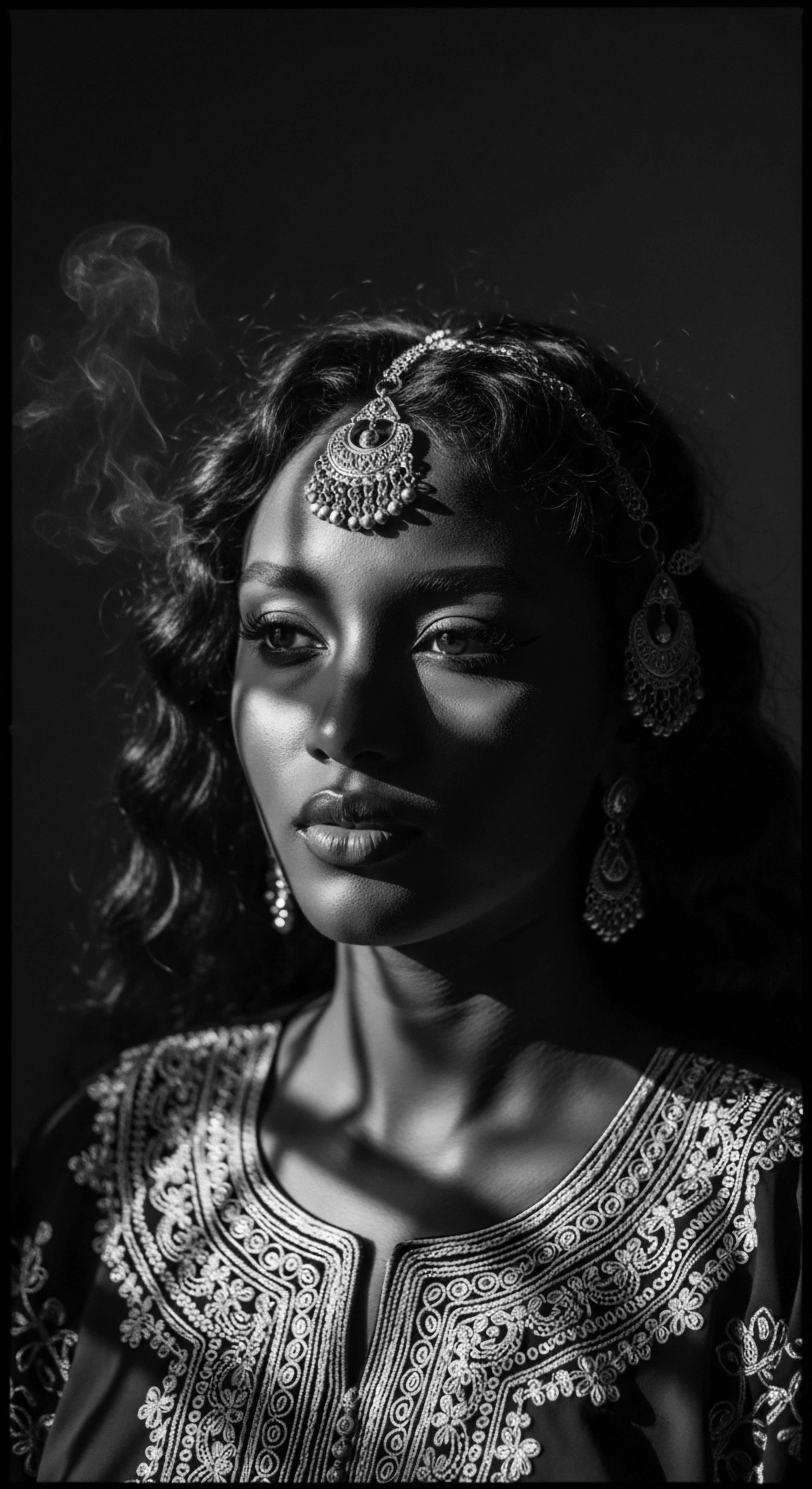
Fundamentals
Within the ancestral memory of hair, where every strand whispers tales of journeys and resilience, we encounter the profound concept of Ancestral Coloring. This idea reaches beyond the mere surface appearance of hair, seeking its true resonance within our genetic blueprint and the enduring cultural narratives that have shaped the perception and care of textured hair across generations. Understanding Ancestral Coloring is akin to reading an ancient scroll, each pigment and curl a character in a story that began long before our own birth.
It suggests that the inherent shades and formations of our hair are not random occurrences, but rather deliberate echoes from the source of our lineage, carrying the very essence of our forebears. This perspective offers a gentle invitation to see our hair not simply as an accessory, but as a living legacy, a testament to the biological heritage passed down through time.
The core meaning of Ancestral Coloring, at its most straightforward, pertains to the inherited spectrum of hues, undertones, and textural formations that define an individual’s hair. This inheritance is a complex dance of melanin production – specifically eumelanin, responsible for black and brown tones, and pheomelanin, which gifts hair with red and yellow pigments – coupled with the unique follicular structures that give rise to the rich diversity of waves, curls, and coils. The varying concentrations and ratios of these melanin types, alongside the particular shape of the hair follicle, dictate whether one’s hair emerges as a deep obsidian, a warm auburn, or a softer, lighter brown. Each expression of color and texture, from the tightest coil to the loosest wave, holds a biological signature, a genetic whisper from generations past.
Ancestral Coloring refers to the inherited spectrum of hair hues, undertones, and textural patterns, reflecting deep genetic blueprints and enduring cultural narratives across generations.

Echoes from the Source ❉ Biological Inheritance
To truly grasp the foundational aspects of Ancestral Coloring, one must journey into the cellular realm. Hair pigmentation originates within specialized cells known as melanocytes, located at the base of the hair follicle. These intricate cellular factories synthesize melanin, which is then packaged into melanosomes and transferred to the keratinocytes, the cells that form the hair shaft itself. The shape and distribution of these melanosomes, alongside the specific types of melanin produced, create the discernible shades of hair.
In textured hair, particularly within Black and mixed-race communities, the biological inheritance manifests in a stunning array of possibilities. We observe hair that can be an impenetrable black, almost absorbing light, or hair that shimmers with deep brown and reddish undertones, especially when touched by the sun’s rays. These variations are not mere superficialities; they are direct biological statements of ancestral origin.
The very structure of the hair strand also speaks volumes about Ancestral Coloring. The elliptical or flattened cross-sectional shape of textured hair follicles, distinct from the rounder follicles of straight hair, contributes directly to the coiling patterns. This architectural difference influences how light reflects from the hair surface, impacting the perceived color and luster. A deeply coiled strand, with its many twists and turns, may appear darker and less reflective than a looser curl, even with similar melanin content.
This optical quality is an important, often overlooked, dimension of Ancestral Coloring, where the physical form inherently dictates an aspect of its visual expression. The science here affirms what ancestral wisdom has long observed ❉ hair is a marvel of inherent design, a signature passed down through the family line.
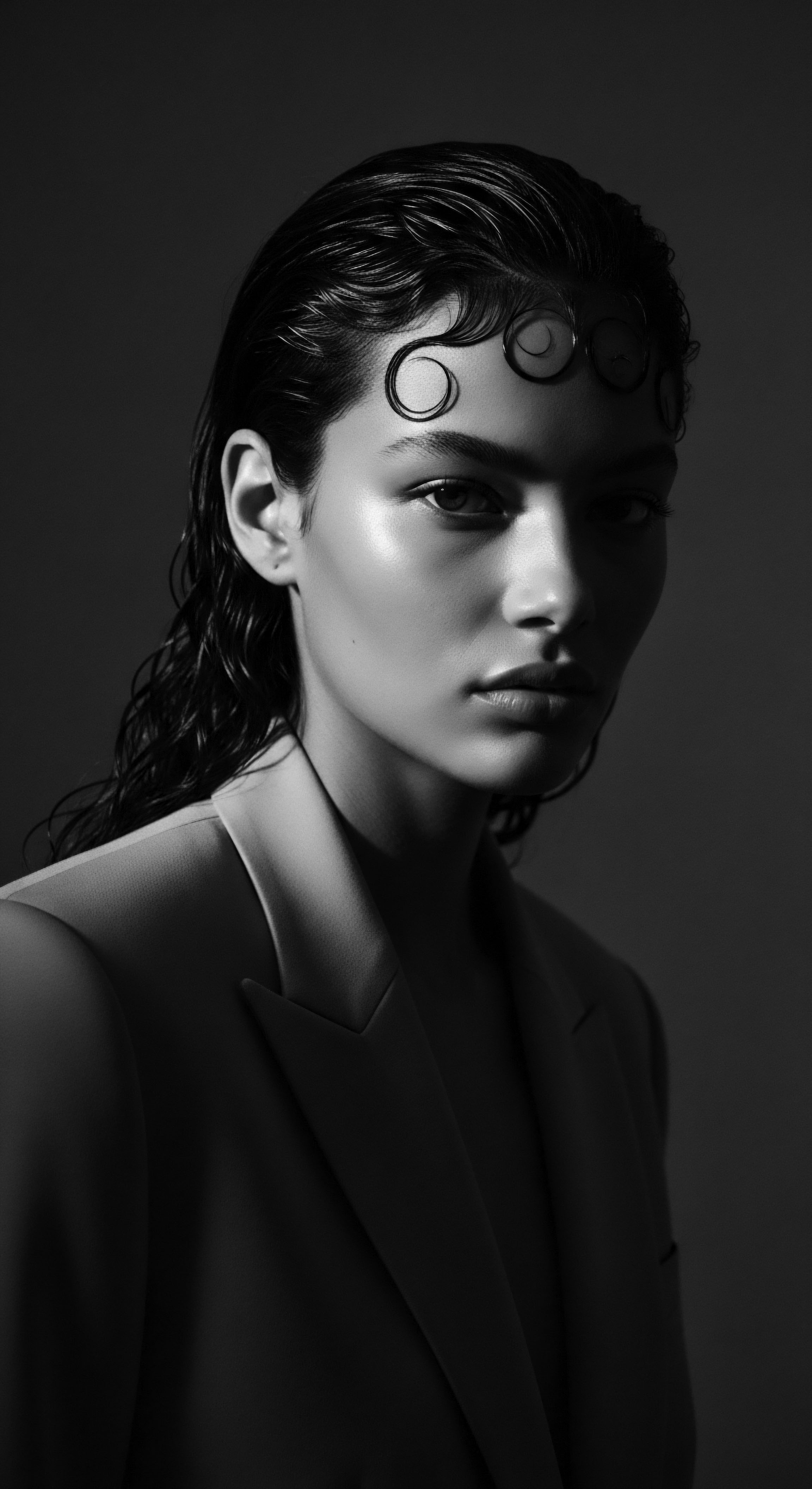
Cultural Lens ❉ Early Understandings and Meanings
Beyond the biological definitions, the meaning of Ancestral Coloring expands into the rich cultural tapestries woven by communities over millennia. For many ancestral societies, especially those in African lands and across the diaspora, hair color and texture were not merely incidental traits; they often signified lineage, tribal affiliation, social status, and spiritual connection. The natural color of hair, untouched by dyes, was revered as an unadulterated link to one’s family and land. This was particularly true in contexts where lighter hair tones were genetically rare; the deep, rich black and brown hues were seen as the natural, quintessential expression of ancestral vitality.
Consider the practices of ancient Nubian societies, where hair was meticulously styled and adorned, often reflecting status and spiritual beliefs. The inherent dark tones of the hair were amplified and celebrated through intricate braiding and the application of natural oils and sometimes minerals that enhanced its sheen. This recognition of the hair’s natural shade as a profound aspect of identity extended to numerous African traditions.
The Inherent Darkness of hair, for instance, could symbolize a connection to the earth, to fertile land, and to the deep wisdom of ancestors. It was a visual affirmation of belonging and continuity, a heritage carried not just in memory but in the very strands on one’s head.
- Melanin Legacy ❉ The dark hues of Black and mixed-race hair are a testament to rich melanin presence, offering natural protection and deep pigment.
- Follicular Blueprint ❉ The specific shape of hair follicles dictates the unique curl patterns inherent to ancestral textured hair.
- Ancestral Adornment ❉ Early communities honored natural hair color, enhancing its beauty through oils and styling, reinforcing its spiritual connection to lineage.

Intermediate
The journey into Ancestral Coloring deepens as we move beyond the initial biological framework to consider its nuanced cultural implications and the historical interplay between inherent hair characteristics and societal perceptions. This intermediate understanding posits that Ancestral Coloring is an active, dynamic concept, shaped not only by the past but also by the living traditions of care and identity that evolve within communities. It encompasses the intrinsic color and texture gifted by our forebears and the ways these attributes have been historically perceived, styled, and given meaning within diverse cultural milieus, particularly for those with textured hair. The conversation shifts to how these innate qualities became symbols, markers, and indeed, living expressions of heritage and resilience through time.
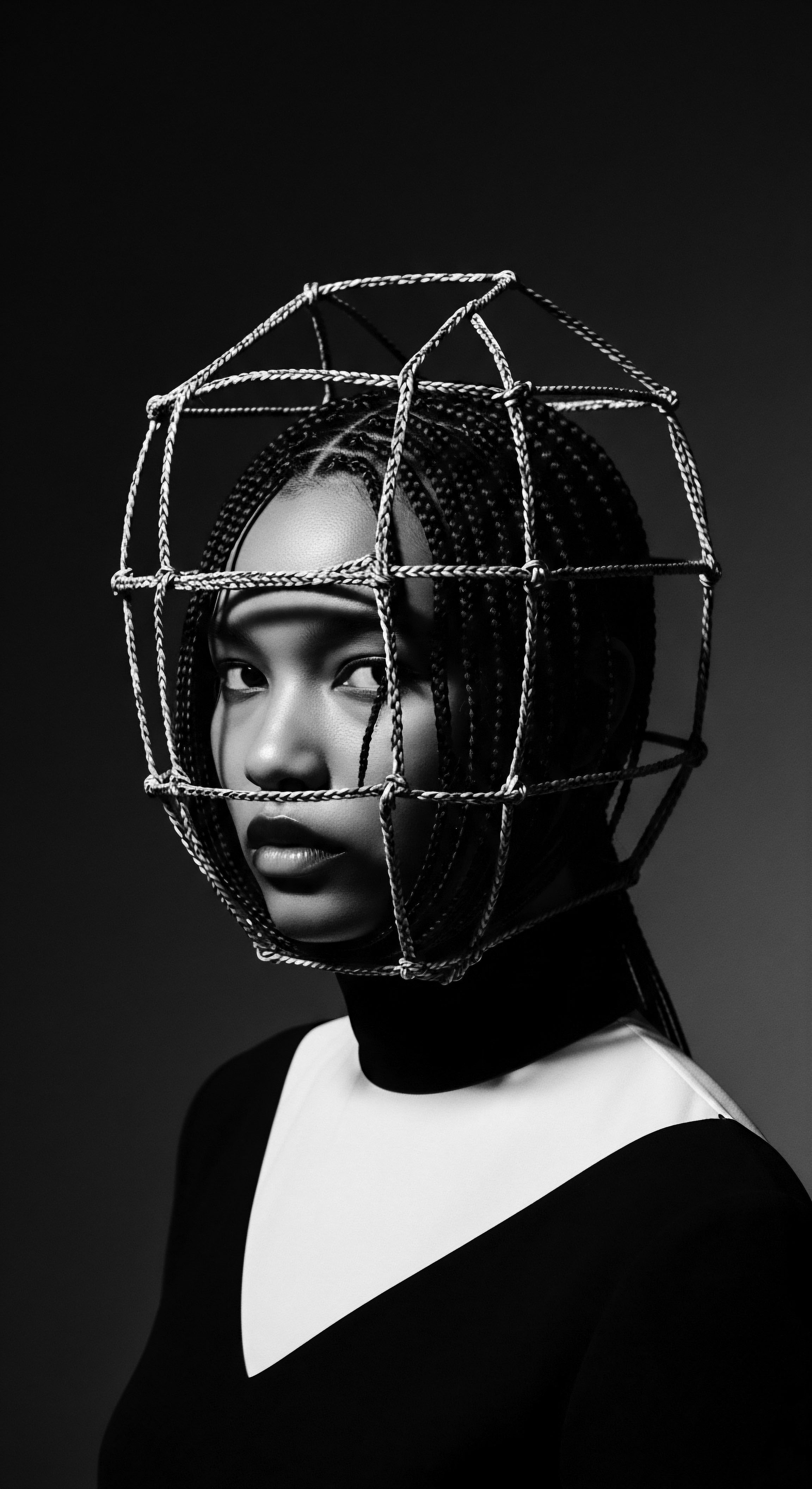
The Tender Thread ❉ Living Traditions of Care and Community
For generations, the care of textured hair has been an intimate, often communal, ritual, deeply interwoven with the understanding of Ancestral Coloring. These practices, passed down through oral tradition and lived experience, were not merely about hygiene or aesthetics; they were acts of reverence for the hair’s inherited qualities. Traditional hair care recognized the unique needs of curls and coils, often utilizing natural ingredients found within the local environment. Consider the practice of hair oiling in various West African cultures, where oils from shea nuts, palm, or other indigenous plants were applied.
These were chosen not only for their moisturizing properties but also, subtly, for how they enhanced the natural luster and depth of the hair’s inherent dark colors. The goal was to nourish the hair in a way that celebrated its natural state, making its Ancestral Coloring vibrant and healthy.
In many communities, the color and texture of hair dictated specific styling practices, each imbued with social or spiritual significance. A child’s first braids, often done with care by an elder, served as a tangible connection to lineage, symbolizing protection and the transfer of ancestral wisdom. The natural dark shade of the hair, therefore, became a visible canvas for these cultural expressions.
The rituals around hair, from washing with natural clays to intricate styling for ceremonial events, were profound acknowledgements of the hair’s intrinsic ties to the ancestral line. The communal nature of these practices – mothers braiding daughters’ hair, friends tending to one another’s coils – reinforced the idea that Ancestral Coloring was a shared heritage, a collective beauty.
Understanding Ancestral Coloring involves recognizing not just inherited hair traits, but also the enduring cultural meanings and care rituals woven around them through generations.
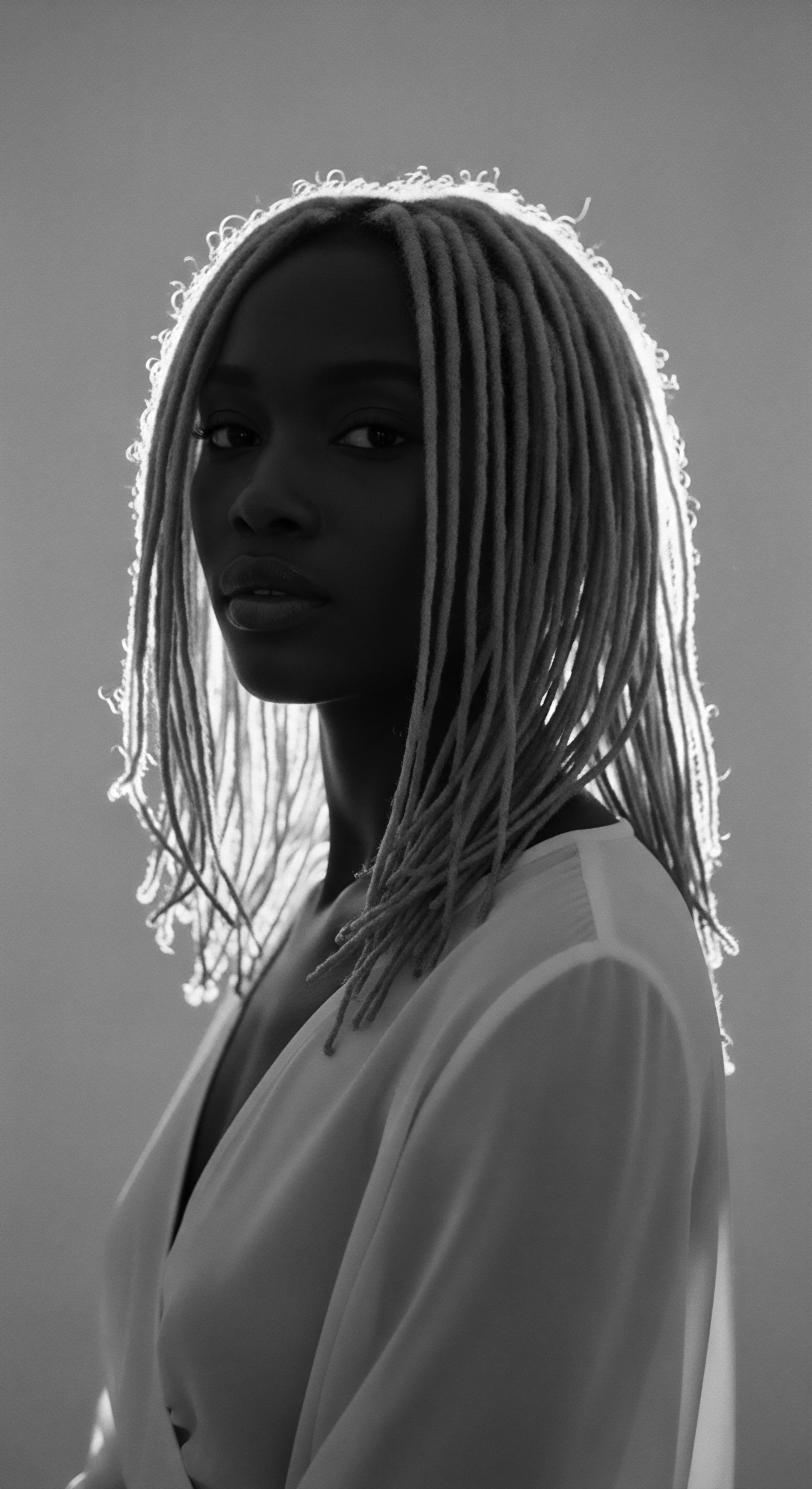
Societal Gazes and Shifting Perceptions
As history progressed, particularly through periods of colonization and diaspora, the societal perception of Ancestral Coloring underwent significant shifts. The inherent characteristics of Black and mixed-race hair—its deep hues and varied textures—were often subjected to external standards of beauty that did not value their natural qualities. This period introduced complexities to the meaning of Ancestral Coloring, as indigenous practices sometimes clashed with imposed ideals.
Yet, even in the face of adversity, communities found ways to reaffirm the value of their hair’s natural state, maintaining traditional styles and care methods as acts of quiet defiance and cultural preservation. The resilience of hair practices, therefore, became a powerful testament to the enduring significance of Ancestral Coloring as a marker of identity.
Take for instance the “conk” or chemical straightening that became prevalent in certain African American communities in the early to mid-20th century. This was, in part, a response to societal pressures to conform to Eurocentric beauty norms that did not celebrate the natural inclinations of Ancestral Coloring in textured hair. Yet, simultaneously, there was an undercurrent of resistance, with many holding steadfast to their coils and braids, cherishing the raw, unapologetic beauty of their inherited hair.
This historical period illuminates how Ancestral Coloring, while biologically static, becomes culturally dynamic, its value and meaning contested and reaffirmed through individual and collective choices. The deliberate act of maintaining one’s natural hair, with its inherent color and texture, often represented a deep connection to a heritage that transcended immediate societal pressures.
| Traditional Practice Herbal Rinses (e.g. hibiscus, cassia) |
| Connection to Ancestral Coloring Enhance natural sheen, subtly intensify dark pigments, cleanse gently. |
| Cultural Significance Maintains hair's inherent vitality, often used for ritualistic purification. |
| Traditional Practice Protective Styling (e.g. intricate braids, twists) |
| Connection to Ancestral Coloring Minimizes manipulation, preserving natural growth and strength of coiled textures. |
| Cultural Significance Communicates social status, tribal affiliation, or life stage; protects hair as a sacred aspect of self. |
| Traditional Practice Natural Oil Application (e.g. shea butter, coconut oil) |
| Connection to Ancestral Coloring Provides moisture and elasticity, accentuating the depth and health of hair's natural color. |
| Cultural Significance Nourishes the hair as a living entity, an act of self-care and generational wisdom. |
| Traditional Practice These practices underscore the deep reverence for hair's natural state, treating Ancestral Coloring as a living archive of heritage. |

The Unbound Helix ❉ Voicing Identity
The ongoing reclamation of natural hair in contemporary times is a powerful reaffirmation of Ancestral Coloring. Individuals are increasingly choosing to wear their hair in its unaltered state, celebrating the wide spectrum of colors and textures that spring from their lineage. This movement acknowledges that the deep browns, the soft blacks, and the often unseen red undertones of textured hair are not simply shades, but statements of identity, resistance, and connection to a rich past.
It is a declaration that the inherited qualities of hair, shaped by centuries of sun, earth, and resilience, are beautiful in their authenticity. This decision to honor one’s Ancestral Coloring becomes a personal and collective act of self-acceptance and a profound tribute to those who came before.
The conversation around Ancestral Coloring, at this stage, moves beyond mere definition to its practical implications in hair care and personal expression. It prompts us to seek products and practices that work in harmony with the hair’s inherent structure and pigmentation, rather than attempting to alter them fundamentally. This means understanding how moisture retention, curl definition, and the enhancement of natural luster are paramount when caring for hair with diverse Ancestral Coloring. It is about fostering an environment where every strand can thrive, embodying the story it carries from its genetic origins, and proudly reflecting the ancestral beauty it represents.

Academic
The academic understanding of Ancestral Coloring delineates it as the genetically encoded expression of melanic pigmentation and follicular morphology, coupled with the profound socio-cultural interpretations and applications of these inherited traits within human populations, particularly those of African descent and the larger diaspora. It is a concept that necessitates an interdisciplinary examination, bridging the realms of genetics, anthropology, sociology, and ethnobotany to fully comprehend its multifaceted significance. This advanced perspective moves beyond surface-level observations, seeking to dissect the biological mechanisms that establish hair’s intrinsic qualities while rigorously analyzing the historical and contemporary power dynamics that have shaped its valuation, symbolism, and practices of adornment. It argues that Ancestral Coloring is not merely a biological fact; it is a complex biocultural construct, an indelible marker deeply intertwined with identity formation, cultural continuity, and resistance within diasporic communities.
The term encompasses the intricate interplay of specific genes that dictate melanin synthesis and distribution, thereby determining the range of black, brown, and sometimes red hues observed in textured hair. Simultaneously, it accounts for the genetic predispositions that result in varied curl patterns, from loosely coiled waves to tightly packed Z-coils, which are characteristic of hair across the African continent and its descendant populations. A comprehensive investigation into Ancestral Coloring therefore requires meticulous attention to the molecular biology of hair, alongside a rigorous historical epistemology of how these inherited traits have been perceived, valued, and sometimes marginalized, particularly through the lens of Eurocentric beauty standards. The enduring presence and deliberate celebration of diverse Ancestral Coloring expressions represent a profound socio-historical statement, a reclamation of inherent beauty against colonial impositions.
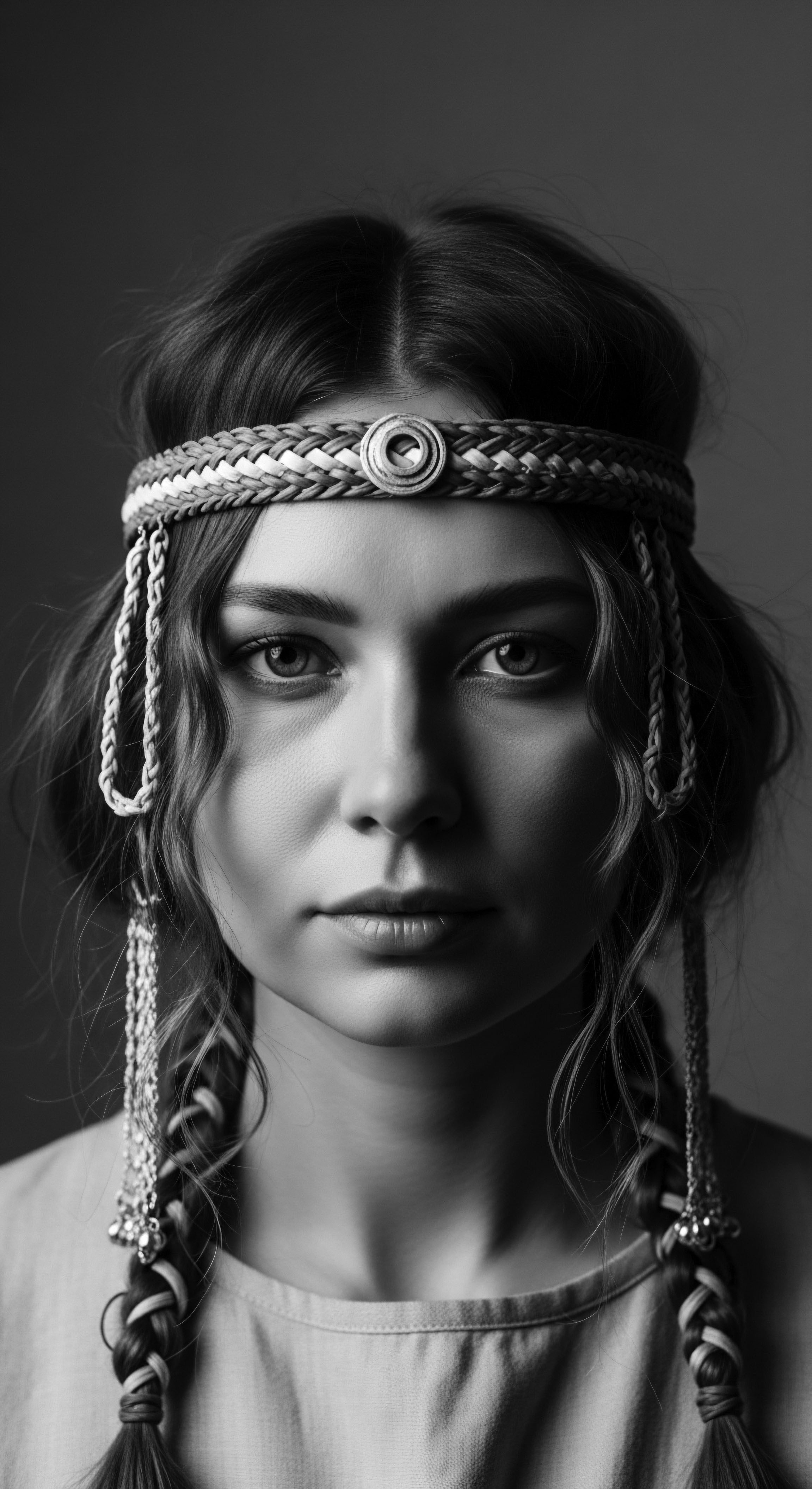
Genomic Echoes ❉ The Science of Inherited Hues and Textures
At the molecular level, Ancestral Coloring is governed by a network of genetic loci, with significant attention paid to genes associated with melanin production and distribution. For individuals with textured hair, the prevalence of eumelanin, responsible for dark brown and black pigments, is particularly notable. Variants in genes such as MC1R, TYR, TYRP1, and OCA2 contribute to the vast spectrum of hair colors observed globally, but their specific allelic combinations define the rich, often deep, shades characteristic of African and diasporic hair.
Research has indicated that genetic variations contributing to tighter curl patterns are also prevalent in these populations, further underscoring the inherited nature of Ancestral Coloring’s textural component. These genetic signatures are ancient, tracing back to the earliest human migrations, carrying with them the biological legacy of adaptations to diverse environments, including sun exposure.
The structural biology of the hair follicle provides additional insights into Ancestral Coloring. The elliptical cross-section of the hair follicle in individuals with tightly coiled hair fundamentally shapes the emerging strand, influencing its ability to retain moisture, its susceptibility to breakage, and its optical properties. The variations in the angle at which the hair follicle emerges from the scalp also play a role in curl pattern and overall hair density. These biophysical realities of Ancestral Coloring have long dictated the traditional care practices developed by communities, which intuitively understood the unique needs of these hair types.
The practices, often rooted in empirical observation over centuries, were designed to work in concert with the hair’s inherent structure, rather than against it. This scientific lens thus offers validation for ancestral methodologies, bridging ancient wisdom with contemporary understanding.
As an illuminating example of Ancestral Coloring’s socio-cultural manifestation, consider the historical use of red earth pigments among the Himba people of Namibia . The Himba women meticulously apply a paste known as otjize, a mixture of butterfat, ochre pigment, and aromatic resin, to their skin and hair. This practice, far exceeding mere cosmetic enhancement, is a profound cultural statement. The reddish-brown hue it imparts to their hair (which naturally carries deep eumelanin tones) is deeply symbolic, representing the color of the earth and the rich red blood of life, connecting them intrinsically to their ancestral land and the cycle of existence.
While their hair’s natural Ancestral Coloring is dark, the application of otjize adds a layer of cultural coloring, signifying beauty, status, and spiritual connection. This demonstrates how the inherent biological expression (the natural hair color) is augmented and given additional layers of meaning through ancestral practices, deepening the very interpretation of “coloring” within a heritage context. The consistency of this practice, passed down through generations, is a living testament to its enduring significance. (Sleeboom-Faulkner, 2017)

Cultural Semiotics ❉ Hair as a Biocultural Archive
From a semiotic perspective, Ancestral Coloring acts as a potent signifier within the cultural lexicon of various communities, particularly those impacted by the transatlantic slave trade and subsequent diasporic movements. The inherent color and texture of Black and mixed-race hair have been historically inscribed with shifting meanings, sometimes denigrated, sometimes celebrated. Early colonial narratives often pathologized African hair textures, framing them as “unruly” or “unclean,” thereby attempting to strip individuals of their connection to their Ancestral Coloring and, by extension, their heritage. This historical context underscores the active suppression of diverse hair expressions as a tool of cultural subjugation.
However, counter-narratives and resistance movements have consistently re-inscribed positive meanings onto Ancestral Coloring. The Black Power Movement of the 1960s and 70s saw the widespread adoption of the Afro, a style that unapologetically celebrated the natural volume and coil of Ancestral Coloring. This was a deliberate political and cultural act, asserting self-acceptance and pride in one’s inherited appearance. This period exemplified the transition of Ancestral Coloring from a mere biological trait to a symbol of collective identity, liberation, and cultural affirmation.
The choice to wear one’s hair in its natural state, showcasing its inherent color and texture, became a powerful statement of solidarity and a rejection of oppressive beauty standards. This historical moment serves as a powerful illustration of how the perception and public display of Ancestral Coloring can become a battleground for, and ultimately a beacon of, cultural autonomy.
The sociological implications of Ancestral Coloring extend to issues of social mobility, professional acceptance, and psychological well-being. Studies have documented the continued bias against natural Black hair in corporate and academic settings, indicating that the aesthetic of Ancestral Coloring, particularly in its more visibly coiled forms, can still be a barrier to opportunity. This highlights the ongoing need for a deeper societal understanding and appreciation of the diverse spectrum of hair, moving beyond simplistic aesthetic judgments to recognize the inherent beauty and cultural richness embedded within Ancestral Coloring. The CROWN Act in the United States, which prohibits discrimination based on hair texture and protective hairstyles, stands as a legislative effort to dismantle these biases, legally affirming the right to express one’s Ancestral Coloring without penalty.
- Genetic Underpinnings ❉ Specific gene variants dictate the precise melanin ratios and follicular shapes that produce the distinct hues and textures of ancestral hair.
- Environmental Adaptations ❉ The deep colors and unique structures of textured hair represent ancient adaptations to varying climates, providing natural protection.
- Biocultural Synthesis ❉ Ancestral Coloring is a fusion of inherited biology and dynamic cultural meaning, where inherent traits become symbols of identity and belonging.
- Diasporic Reclamation ❉ Contemporary movements celebrate and reclaim diverse expressions of Ancestral Coloring as acts of self-affirmation and cultural pride.

Long-Term Consequences and the Future of Understanding
The long-term consequences of either embracing or suppressing Ancestral Coloring are profound, impacting individual psychological well-being and collective cultural resilience. When individuals are encouraged to appreciate and care for their hair in its natural state, it fosters a deeper sense of self-acceptance and connection to their heritage. Conversely, societal pressures to alter or conceal one’s Ancestral Coloring can lead to diminished self-esteem, body image issues, and a disconnection from one’s lineage.
This psychological burden, though often unseen, is a significant aspect of the ongoing discourse surrounding hair and identity. The validation of Ancestral Coloring, therefore, is not merely an aesthetic choice; it is a vital component of holistic wellness and cultural affirmation.
The future of understanding Ancestral Coloring involves not only continued scientific research into the genetics and biology of hair diversity but also a deeper excavation of historical and anthropological records. This deeper excavation should aim to uncover more of the lost or marginalized ancestral practices of hair care and adornment, recognizing their ingenuity and relevance. It requires a commitment to decolonizing beauty standards, elevating the inherent beauty of all hair types, and fostering environments where individuals can confidently express their Ancestral Coloring without fear of judgment or discrimination. This ongoing process acknowledges that the wisdom embedded in traditional hair practices often holds keys to optimal hair health for diverse textures.
The scholarly pursuit of Ancestral Coloring’s meaning extends to analyzing the economic and social impacts of the natural hair movement. This includes the emergence of culturally responsive product lines and the rise of hair stylists specializing in textured hair. These developments, driven by a renewed appreciation for Ancestral Coloring, represent a significant shift in the beauty industry, moving towards inclusivity and authenticity.
The economic empowerment within these communities, stemming from the celebration of their inherent hair traits, illustrates a tangible positive outcome of embracing Ancestral Coloring. Ultimately, the comprehensive definition of Ancestral Coloring demands that we view hair not as a superficial attribute, but as a living bridge between past, present, and future, carrying the indelible signature of ancestry.

Reflection on the Heritage of Ancestral Coloring
To ponder Ancestral Coloring is to stand at the crossroads of time, feeling the gentle breeze of generations past mingling with the vibrant currents of the present. It is to recognize that the very strands upon our heads are not merely keratinized protein; they are living archives, each curl and pigment imbued with the wisdom, resilience, and beauty of those who walked before us. This concept, far from a static definition, breathes with the dynamic spirit of heritage, reminding us that our hair is a profound extension of our ancestral story, a visible manifestation of enduring lineage.
The journey of understanding Ancestral Coloring leads us through the sacred rituals of ancient African communities, where hair was revered as a conduit for spiritual connection and a marker of identity. It guides us through the turbulent tides of history, where the inherent beauty of textured hair was often challenged, yet steadfastly persevered as a silent act of defiance and cultural preservation. And it brings us to the contemporary moment, a beautiful renaissance where individuals reclaim their coils, kinks, and waves, celebrating them as potent symbols of self-love and connection to their roots. This ongoing narrative affirms that the deep hues and unique textures of Black and mixed-race hair are not just biological traits; they are declarations of belonging, whispers of collective memory, and affirmations of an unbroken line.
Ancestral Coloring serves as a living testament to inherited beauty, cultural resilience, and the enduring connection between hair, identity, and lineage across generations.
In the gentle philosophy of Roothea, the Soul of a Strand finds its truest expression within the framework of Ancestral Coloring. Every decision made about our hair, from the products we choose to the styles we embrace, becomes an act of honoring this inherent heritage. It calls upon us to listen to the whispers of our hair, to understand its unique needs stemming from its ancestral blueprint, and to nourish it with the same reverence and care that our foremothers did.
This reflection on Ancestral Coloring invites a deeper, more soulful relationship with our hair, fostering a profound appreciation for its intrinsic beauty and its powerful capacity to connect us to the grand, unfolding story of our ancestry. It is a quiet revolution, spun from every magnificent strand, celebrating the timeless art of who we truly are.
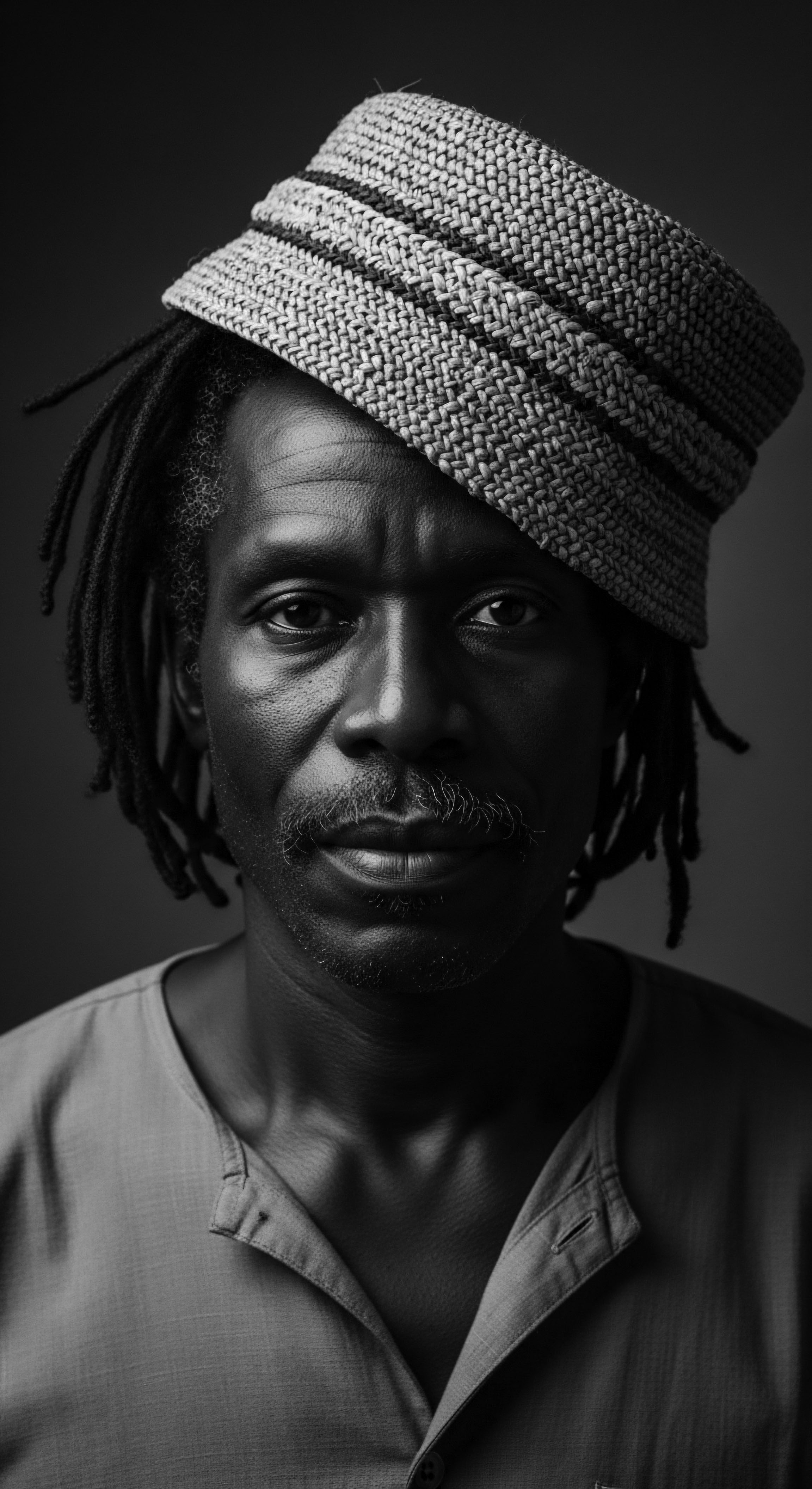
References
- Sleeboom-Faulkner, M. (2017). The Himba of Namibia ❉ Their hair, skin and body language in relation to their culture and beliefs. In V. Tarasova (Ed.), African Beauty and Adornment. Springer.
- Byrd, A. D. & Tharps, L. (2002). Hair Story ❉ Untangling the Roots of Black Hair in America. St. Martin’s Press.
- Mercer, K. (1994). Welcome to the Jungle ❉ New Positions in Cultural Politics. Routledge.
- Banks, I. (2000). Hair Matters ❉ Beauty, Power, and Black Women’s Consciousness. New York University Press.
- Garth, M. (2017). African-American Hair Culture ❉ Cultural Identity and Expression. Palgrave Macmillan.
- Jackson, R. L. (2001). The Social Construction of the Black Body ❉ Cultural Perceptions of Physical Appearance and Identity. Hampton Press.
- Kittles, R. A. & Weiss, K. M. (2003). Race, Ancestry, and Genes ❉ Implications for Defining Disease Risk. Annual Review of Genomics and Human Genetics, 4, 33-67.
- Fraser, K. (2018). The African Hair Revolution ❉ An Illustrated History. Rizzoli Electa.
